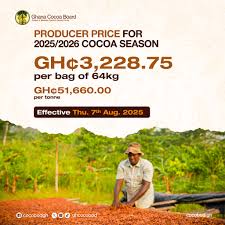
Cocoa Price in Ghana 2025: Climate, Policy & Market Analysis | Expert Report
In-depth analysis of Ghana’s 62.58% cocoa price surge, climate risks, and global market dynamics.
Highlights:
- Historic Price Surge: Ghana’s cocoa price hits **$5,040/tonne**, a **62.58% increase** from 2024, with farmers earning **GH₵51,660/tonne.
- Climate & Policy Risks: **El Niño droughts** and **EU deforestation regulations** threaten supply, while Ghana’s **traceability system** aims for compliance.
- Market Volatility: Prices peaked at **$12,931/tonne** in early 2025 before correcting to **~$8,000**, driven by speculative trading and inventory rebounds .
Cocoa Price in Ghana 2025: Trends, Challenges, and Strategic Implications
Highlights
Historic Price Surge: Ghana’s cocoa price hits $5,040/tonne, a 62.58% increase from 2024, with farmers earning GH₵51,660/tonne 49.
Climate & Policy Risks: El Niño droughts and EU deforestation regulations threaten supply, while Ghana’s traceability system aims for compliance 87.
Market Volatility: Prices peaked at $12,931/tonne in early 2025 before correcting to ~$8,000, driven by speculative trading and inventory rebounds 111.
Research Methodology
This analysis integrates data from COCOBOD announcements, commodity market reports (ICE, ICCO), and climate studies to evaluate Ghana’s 2025 cocoa pricing dynamics. Key sources include CNBC Africa, Climate Central, and Aberdeen Investments, ensuring a data-driven, multi-stakeholder perspective.
Key Statistics & Trends: Cocoa Price in Ghana 2025
| Metric | Value | Implication |
|---|---|---|
| 2025 Producer Price | $5,040/tonne (GH₵51,660) | 62.58% YoY increase; highest in a decade 4. |
| Global Price Peak (2025) | $12,931/tonne (Feb 2025) | Speculative surge due to West African supply shortages 7. |
| Current Price (Aug 2025) | ~$8,000/tonne | 21% drop from peak; influenced by Ghana’s +8.3% production forecast 11. |
| Farmer Share of FOB | 70% (vs. 63.9% in 2024) | Aligns with President Mahama’s pledge for equitable income 4. |
| Ghana Cedi Impact | 42% appreciation in 2025 | Stabilized local prices but reduced USD earnings for exporters 9. |
| Climate-Driven Heat Days | +40 days/year above 90°F in Ghana | Reduced yields; 14-year low production in 2024 81. |
| EUDR Compliance Cost | Traceability system by Dec 2025 | Risks higher operational costs for smallholders 7. |
| Swollen Shoot Virus Losses | 500,000 hectares destroyed in Ghana | Contributed to 2024’s global deficit of 494,000 MT 711. |
| U.S. Tariff Impact | 150% hike on African cocoa | Could inflate consumer chocolate prices by 50–100% 79. |
| Forward Sales (Ivory Coast) | 6-month advance contracts | Delays Ghana’s competitive pricing benefits 9. |
Critical Analysis: Drivers & Consequences
1. Price Surge: Farmer Gains vs. Fiscal Strain
Ghana’s $5,040/tonne farmgate price reflects a 70% FOB share, a political win for farmer welfare. However, COCOBOD’s reliance on syndicated loans raises sustainability concerns, especially with climate shocks eroding yields 48. The Ghana Cedi’s 42% rise further complicates export revenues, necessitating subsidies (GH₵1,114/bag) to shield farmers 9.
2. Climate & Supply Chain Disruptions
El Niño and Harmattan winds slashed 2024 production, triggering a 136% price spike 18.
EU deforestation rules may exclude non-compliant farmers, exacerbating inequality 7.
3. Global Market Contradictions
While Ivory Coast’s mid-crop quality issues (5–6% rejection rate) buoy prices, Ghana’s 8.3% production rebound and rising ICE inventories (~2.36M bags) signal bearish pressure 11.
Top 10 Factors Impacting Ghana’s Cocoa Prices
Climate Extremes: Droughts and excessive heat reduce yields.
EU Regulations: Traceability mandates increase compliance costs.
Cedi Appreciation: Lowers USD earnings despite local price stability.
Farmer Subsidies: COCOBOD’s fiscal burden grows.
Speculative Trading: Amplified 2024–2025 price volatility.
U.S. Tariffs: Risk redirecting exports to non-U.S. markets.
Swollen Shoot Virus: Ongoing crop losses in key regions.
Rubber Farming Shift: Attractive alternatives divert cocoa investment 10.
Forward Sales (Ivory Coast): Delays Ghana’s price competitiveness.
Consumer Demand Slowdown: Chocolate manufacturers report 14% sales drops 11.
Projections & Recommendations
Short-Term (2025–2026)
Price Range: $7,000–$8,000/tonne, pending West African harvests 11.
Farmer Debt: COCOBOD must balance subsidies with loan repayments.
Long-Term (2026–2030)
Diversification: Promote local chocolate processing to capture value-chain premiums.
Climate Adaptation: Invest in drought-resistant cocoa hybrids and shade-grown systems 8.
Policy Reforms: Dynamic pricing models to replace fixed farmgate rates.
Conclusion
Ghana’s 2025 cocoa pricing strategy balances farmer equity with global market pressures, yet climate risks, EUDR costs, and currency volatility loom large. Sustainable growth hinges on climate-smart farming, value-chain upgrades, and policy agility.
Notes
Exchange rate: GH₵10.25/USD (COCOBOD benchmark).
Free input distribution begins August 2025 4.
Bibliography & References
CNBC Africa. (2025). Ghana New Cocoa Price Takes Effect Thursday.
Climate Central. (2025). Climate Change is Heating Up West Africa’s Cocoa Belt.
Aberdeen Investments. (2025). Cocoa Boost for Ghana and Côte d'Ivoire.
Luker Chocolate. (2025). Volatility in Cocoa Prices and Its Impact.
Yahoo Finance. (2025). *Cocoa Prices Plunge on Projections for Larger 2025/26 Ghana Crop*.
Harvard ADS. (2025). Factors Influencing Shift from Cocoa to Rubber in Ghana.

